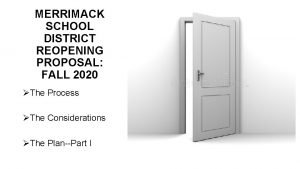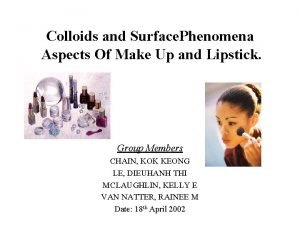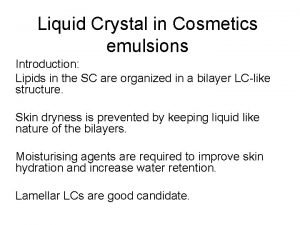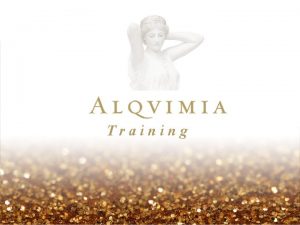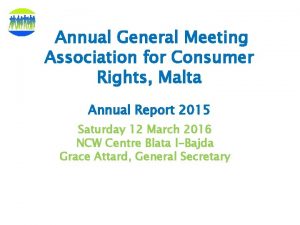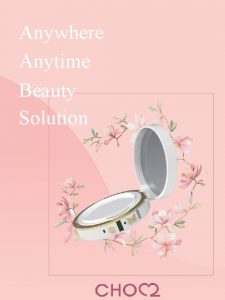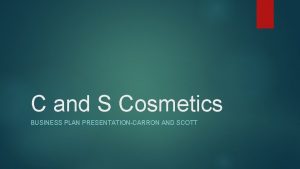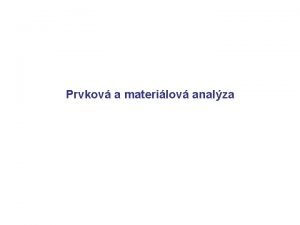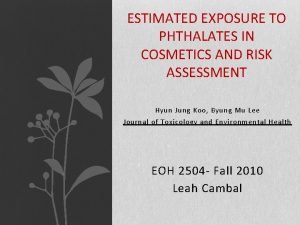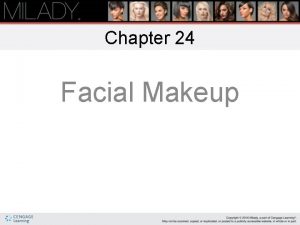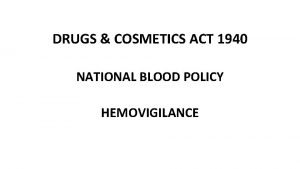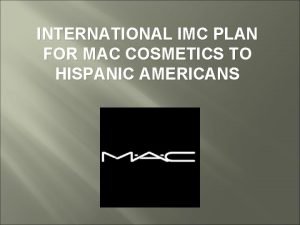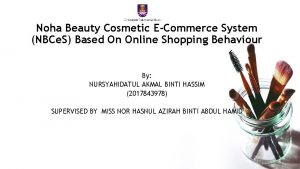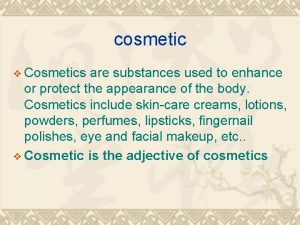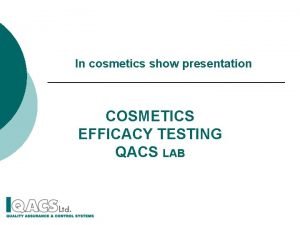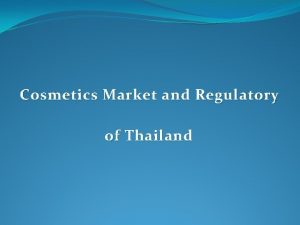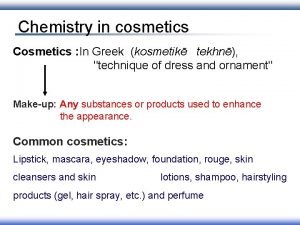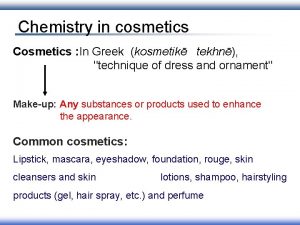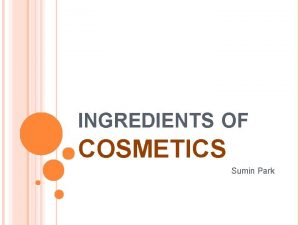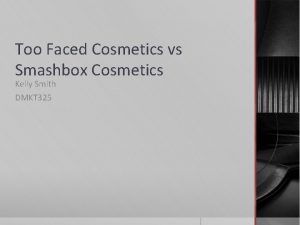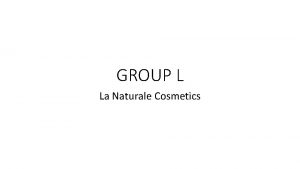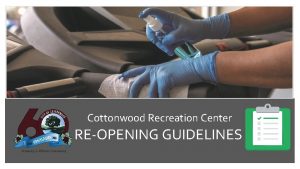COSMETICS ALLIANCE CANADA Guidance for ReOpening InPerson Cosmetics











































- Slides: 43

COSMETICS ALLIANCE CANADA Guidance for Re-Opening In-Person Cosmetics Retail This guidance is no substitute for the advice and direction of your government and health authorities. Always comply with local regulations. This guidance is intended to assist in identifying and mitigating risks to promote the safety of your sales team and their customers. 1

TABLE OF CONTENTS Page 3: Introduction Page 11: 1. The Retail Space Page 15: 2. The Beauty Advisor (and their workspace) Page 19: 3. Customer Interactions (product demos, make-overs) Page 33: 4. Makeup Tools (keeping them clean) Page 38: 5. Direct Sellers Page 40: Training: The Need to Understand the “What & Why” of Mitigation Page 44: Resources & Links to Materials 2

INTRODUCTION 3

WHAT WE KNOW ABOUT COVID-19 • Virus spread through: - respiratory droplets generated when you cough/sneeze - prolonged personal contact (touching, shaking hands) - touching something with the virus on it, then touching mouth, nose or eyes before washing hands • Survives on surfaces from several hours to days (depending on surface type, humidity, temperature); but can be inactivated on surfaces by using disinfectants • Currently, no proven treatment or vaccine • Mortality rate double that of flu (~3. 5% worldwide) 4

THERE ARE NO GUARANTEES IN PREVENTING THE TRANSMISSION OF COVID-19 Currently, there is only Risk Mitigation! Common methods to reduce the risk of exposure: • Minimize contact with others • Social distancing (6 ft or 2 m) • Wear personal protective equipment • Wash hands frequently • Disinfect surfaces (as well as products, tools, etc. ) 5

HOW COVID-19 EASILY SPREADS THE BENEFIT OF MITIGATION 6

GENERAL RE-OPENING RULES • Each jurisdiction/community different • Always follow the advice and direction of local government and health authorities • Always comply with local regulations • Also, look for guidance from sectorspecific trade, industry, and professional associations 7

“IN-PERSON” COSMETICS RETAIL As communities begin to re-open retail … Q How do we open-up “in-person” cosmetics retail as safely as possible? Q How do we continue to mitigate risk? 8

INTENT OF THIS GUIDANCE Assist our members to Identify and Mitigate Risks to promote the safety of our: • • beauty advisors/service providers, direct sellers, brand representatives, and their customers and clients 9

BREAKING DOWN THE CHALLENGE What You Need to Considered 1. 2. 3. 4. 5. The Retail Space The Beauty Advisor (and their workspace) Customer Interactions (product demos, make-overs) Makeup Tools (keeping them clean) Direct Sellers 10

1. THE RETAIL SPACE As workplaces begin to reopen, it is important that good practices are in place to prevent the spread of COVID-19! 11

1. THE RETAIL SPACE, continued General Recommendations: ü ü Control store access (“ 1 in / 1 out”, curbside pickup) Provide hand-sanitizer at store entrance Require the use of masks Ensure physical distancing (signage, directional aisles, plexiglass shields, etc. ) ü Control access to products ü Do not allow testers for self-use ü Ensure frequent, scheduled cleaning and sanitization of the store (including washrooms) 12

1. THE RETAIL SPACE, continued Resources: Tip Sheets: (click to download) • Retail • General Re-opening Detailed Retail Guidance: Retail Council of Canada’s Road to Retail Recovery Playbook (available HERE) 13

1. THE RETAIL SPACE, continued Resources: Signage: (available HERE) 14

2. THE BEAUTY ADVISOR Recommendations to Protect the BA: ü Ensure BA is willing and able to return to work ü Conduct and document wellness check prior to shift ü Ensure physical distancing, proper signage, and availability of hand sanitizers/hand-washing stations throughout store and at Beauty counter ü Install plexiglass shields at Beauty counter ü Establish and post protocols for Beauty counter/workspace set-up and customer interactions ü Provide personal protective equipment (PPE) especially masks and/or face-shields ü Re-assure BA with frequent, clear communications 15

2. THE BEAUTY ADVISOR, continued Resources: Tip Sheets: (click to download) • COVID-19 Screening Tool • Preventing Stigma Check-lists for the BA: (see pages 17 and 18) • Arriving at your Workplace • Setting up your Workspace 16

Check-list for the Beauty Advisor: ARRIVING AT YOUR WORKPLACE ü Locate and use the designated area for locking up personal belongings (purse, cell phone, medications, food NOT to be near workspace) ü Wash and sanitize hands ü Apply face mask and gloves ü Clean frequently touched surfaces (purse/cell phone) with disinfectant before putting items away in locker or cupboard (tip: use hands-free mode on cell phone to avoid touching face) ü Handle uniforms as little as possible (tips: wash clothes at > 60 deg C for at least 30 minutes; long sleeves recommended; do not reuse uniforms, smocks, aprons) Personal Protection Equipment Kit: 17

Check-list for the Beauty Advisor: SETTING UP YOUR WORKSPACE ü ü ü ü Apply makeup in designated application areas only Do not allow anyone to touch or test any products Cover all cosmetic displays with acrylic shields or wrap Only products stored in a controlled, secured area (closed kit, drawer behind counter) should be used for application Never work with products that have been left open and exposed to the environment or unattended Have numerous sets of product available so you can rotate products being used Sanitize each product set before a rotation quarantine for a minimum of seven days Post appropriate signage to assure customers of the safe practices in place and promote compliance 18

3. CUSTOMER INTERACTIONS Recommendations: ü Makeup, skincare, and fragrance testers should NOT be on display ü ALL tester/sampling products must be stored and secured in a controlled space not accessible to the public ü Establish strict protocols for product handling and testing as well as makeup application to ensure the safety of the BA and customer ü Only trained BA’s should help customers test a product ü Sanitize all products before and after each customer interaction ü Use face charts, smudge sheets, and blotters as applicable for makeup, skincare, and fragrance product testing ü Only single-use, disposable applicators are to be used for product sampling or application 19

3. CUSTOMER INTERACTIONS, continued Resources: Elevated Best Practices & Prevention Measures for the Cosmetic Industry (click to download) Check-lists for the BA: (see pages 31 and 32) • Before & After Each Application • Protecting Your Customer 20

3. CUSTOMER INTERACTIONS, continued Excerpts from Beauty. So. Clean’s® Elevated Best Practices & Prevention Measures for the Cosmetic Industry: Makeup Application Protocol for the Beauty Advisor A. Steps to Take Before Starting an Application B. How to Handle Makeup Products and Tools C. When Applying Makeup D. Alternative to Applying Makeup on the Face 21

A. Steps to Take Before Starting an Application 1. Ask your customer for a health check. 2. Have them complete the consumer agreement (including contact tracing info). 3. Don’t share pens (if customer needs to use your pen, disinfect before and after use). 4. No personal belongings on counter (ask customer to put their phone away and do not allow purses or handbags on your workspace counter). 5. Have your customer place their personal belongings on the floor in front of them by their feet. 22

A. Steps to Take Before Starting an Application 6. Ask your customer if they have ever experienced a reaction to makeup/skincare? If so, what kind? 7. Ask if they have allergies of any kind (i. e. shellfish, peanuts). Keep in mind that some people may also have reactions to fragrance. 8. Ask if your customer is wearing contact lenses. Contactwearers are much more prone to eye irritation; if you plan on using any products with a strong scent, your customer should keep their eyes closed while you’re working to prevent excessive tearing. 9. If your customer has irritated or broken skin, do not apply any product. Do not treat a client if they have open sores, pink eye, or a fever. If a product irritates your customer’s skin, remove it immediately and discontinue use. 23

B. How to Handle Makeup Products and Tools 1. ALL sampling products must be stored and secured in a controlled space not accessible to the public. 2. Each product must be sanitized before and after each application. 3. Only single-use, disposable applicators are to be used for product sampling or application (suggested disposable applicators on pages 9 & 10 of the Elevated Best Practices & Prevention Measures for the Cosmetic Industry). 4. One fully cleaned cosmetic brush set is to be used per customer. 5. If sampling with a face chart, all products must be sanitized before and after each use. 24

B. How to Handle Makeup Products and Tools 6. Rotate each set of testers every seven days. When opening any new product, immediately discard the applicators that come with the product. - Replace testers being used in the controlled storage area at store level regularly. - Prepare personal makeup kits for talent on air. - Organize kits of new products for bridal parties ahead of time. 7. Protocol should include specific instructions for: pencils, powder-based products, loose powders, liquid products, mascara, cream compounds, tubes, lipsticks, sponge and brush tips (specific instructions on pages 15 & 16 of the Elevated Best Practices & Prevention Measures for the Cosmetic Industry). 25

C. When Applying Makeup 1. Only use clean, sanitized tools to transfer product. 2. Use a new, sanitized, disposable applicator to remove product from its container. 3. Always wear gloves. Never dip your fingers directly into the packaged product to remove it. Never double-dip by placing applicators or product back into a product container. Never use your hands to apply any cosmetics. 4. Once product has touched the skin, use a new, sanitized, disposable applicator to gather more from the container. 5. Only use disposable applicators, and cosmetic brushes that have been soaked/washed/dried/sanitized. 26

C. When Applying Makeup 6. Only use a new set of clean brushes or sanitized disposable applicators to touch your customer’s skin. Place all used brushes in a sealable bag or closed dirty brush container and throw out all used disposable applicators. Never leave used brushes or applicators on your set up area. 7. When working with makeup brushes, tap or shake off excess product – never blow it off. 8. Dispense product in containers with pumps or droppers directly onto your applicator or palette without touching any surfaces. Do not let the dispenser touch the palette. 9. Use a spatula or palette - Complete any mixing required on the spatula or palette to prevent any foreign substances from touching the product. - When moistening or activating product on the palette, always use sterile water from a sealed bottle. 27

D. Alternative to Testing Cosmetics on Face Use a custom skin tone face chart, such as that offered by Beauty. So. Clean® or other reputable suppliers. Found on pages 19 – 36 of the Elevated Best Practices & Prevention Measures for the Cosmetic Industry 28

Customizable Face-Charts Available from Beauty. So. Clean®

Check-list for the Beauty Advisor: BEFORE & AFTER EACH CUSTOMER APPLICATION ü Remove and dispose gloves that were used for a previous customer ü Wash your hands. If a sink is not available, use a hand wipe to thoroughly wipe hands ü Apply hand sanitizer ü Apply fresh gloves 30

Check-list for the Beauty Advisor: SAFEGUARDING YOUR CUSTOMER ü Offer your client gloves if they are not already wearing any PPE; have disposable sealable bags available to store their face mask; do not allow your customer to touch their face at any time ü Cover your client with a disposable makeup cape; keep your customers pristine by tucking a clean tissue into their collar prior to an application ü Read all directions and warnings on packaging and follow them carefully ü Place new disposable paper towels on your work set up area and replace with each customer ü Choose the products you will be using from your controlled storage area ü In front of your customer sanitize all cosmetic products that you have selected to apply after sanitizing all products Allow 15 minutes for disinfecting hard surfaces, sanitizing cosmetics, cleanup, and preparation for your next customer. 31

4. MAKEUP TOOLS, continued Recommendations: ü Establish strict protocols for the handling, cleaning and disposing of makeup tools to ensure the tools do NOT become a means for spreading COVID-19 ü Tools must be stored and secured in a controlled space not accessible to the public ü Use single-use, disposable tools for product sampling and application wherever possible ü Sanitize non-disposable tools (e. g. brushes) before and after each use 32

4. MAKEUP TOOLS, continued Resources: Elevated Best Practices & Prevention Measures for the Cosmetic Industry (click to download) Guidelines for Tools (see pages 35 - 37) 33

GUIDELINES FOR TOOLS 1. Use disposable applicators and keep in a closed container. 2. Never leave applicators in an open and exposed environment. 3. Do not double dip or use disposable applicators on more than one product. 4. Use bottled water when a sink is not available. If you have a sink available, disinfect the sink before and after each use. 5. Makeup brush sets can be used only once per client. 6. Designate brushes for each person or use disposable applicators. 7. Soak/Wash/Dry/Sanitize each set of brushes used during a shift. 34

GUIDELINES FOR OTHER TOOLS 1. Only use stainless steel pencil sharpeners, eyelash curlers and palettes. These tools can be cleaned with a disinfecting solution in between each client. Metal tools can be disinfected with a wipe. 2. Pencil sharpeners and eyelash curlers need to be sanitized by soaking for one minute in 70% IPA alcohol in a stainless steel or glass container. 3. Eyelash curler bands need to be replaced between each customer and disposed in the safe disposal container. 4. Before using your sharpener in front of your client spray your sharpener with sanitizer and blot it with a clean tissue. 5. Always keep a selection of disposable applicators in a closed container, and remove the pieces required once you have determined your application process requirements. 35

GUIDELINES FOR OTHER TOOLS 6. Applicators can be used for multiple purposes if working with a metal palette. Never use one applicator to transfer product from various items for one makeup application. 7. Always sanitize products in front of your client before using disposable applicators, when working with face charts, or when testing product on a customer’s skin. 8. Always dispose of single-use applicators in a safe disposal container. Step 1: Clean your workspace with a disinfectant wipe. Step 2: Place fresh disposable paper towel on your workspace. Step 3: Choose your applicator and place on clean paper towel. Step 4: Choose your product and place on clean paper towel. Step 5: Sanitize your products before and after working with each applicator. Makeup is a porous surface and when open and exposed to the environment cross contamination can occur. 36

5. DIRECT SELLERS Recommendations: ü Direct Sellers must follow the local Public Health rules for interaction when meeting a client or customer in-person ü Direct Sellers should follow the same “in-store” rules and guidance outlined above for product demonstrations and make-overs during an inhome consultation ü Direct Sellers should follow the same rules and guidance for safeguarding tools 37

Additional Check-list for the Direct Seller: IN-HOME SALES EVENTS ü For a Direct Seller (DS) customer home visit or event, the DS needs to ensure the customer’s home or venue is safe and meets local Public Health requirements (i. e. has anyone in household had COVID-19, have they been social distancing, are there any other risk factors present) ü The DS should keep a list of where they have been and who they have interacted with for Public Health tracing purposes; if an event involves more that the home-owner, all attendees should sign an appropriate agreement like that required for in-store customers (including info for contact tracing); avoid sharing pens, otherwise sanitize ü The DS should use appropriate PPE and ensure PPE is available for attendees, especially facemasks ü The DS must comply with local rules for mitigation including limitations on the number of individuals that can gather, and their relationship ü Venues should be cleaned and sanitized before an event, washrooms kept cleaned, and hand-sanitizers 38 made available

TRAINING: THE NEED TO UNDERSTAND THE “WHAT & WHY” OF MITIGATION It’s important to understand what to do (i. e. the check-list), BUT it’s equally important to understand why you are doing it! 39

TRAINING: THE NEED TO UNDERSTAND THE “WHAT & WHY” OF MITIGATION She gets credit for wearing a mask, BUT doesn’t understand why. And in not understanding, the benefit can be lost. Training your teams to understand both the “What & Why” will ensure success in re-opening! 40

TRAINING Do you or your staff require training? Contact: Nancy Crossley President, Professional Artists (Canada) Inc. Beauty. So. Clean® ncrossley@proartistsint. com Diane Kozak Cosmetics Alliance Beauty Specialist Certification Program dkozak@cosmeticsalliance. ca 905 -890 -5161 ext. 223 41

Training Your Influencers! Beauty Specialist Certification Program • Online courses on the science and safety of personal care products • Provides Beauty Specialists with the knowledge and confidence to address consumers’ questions and concerns Diane Kozak dkozak@cosmeticsalliance. ca 905 -890 -5161 ext. 223 More info: click HERE 42

RESOURCES Ø Allied Beauty Association: www. abacanada. com Salon Re-Opening Resources (available HERE) Ø Canadian Centre for Occupational Health & Safety: www. ccohs. ca Tip Sheets: (click to download) Retail General Re-opening COVID-19 Screening Tool Preventing Stigma Signage: (available HERE) Ø Retail Council of Canada: www. retailcouncil. org Road to Retail Recovery Playbook (available HERE) Ø Beauty. So. Clean ® Elevated Best Practices & Prevention Measure for the Cosmetics Industry (click to download) 43
 Merrimack school district reopening
Merrimack school district reopening Bloomfield hills schools reopening
Bloomfield hills schools reopening Sachem school district reopening plan
Sachem school district reopening plan Lincoln parish school board
Lincoln parish school board Reopening plan
Reopening plan Coatesville area school district reopening
Coatesville area school district reopening Nadia nashir
Nadia nashir Semi anatomic teeth degree
Semi anatomic teeth degree Example of indirect guidance
Example of indirect guidance Sap university alliance canada
Sap university alliance canada Mary kay philosophy
Mary kay philosophy Example of oily binder in compact
Example of oily binder in compact Desert daughter
Desert daughter Liquid crystal cosmetics
Liquid crystal cosmetics Alquimia essential oil
Alquimia essential oil Bsc cosmetics
Bsc cosmetics Noha moral
Noha moral Choc choc cosmetics
Choc choc cosmetics Cosmetics business proposal
Cosmetics business proposal Vanesa cosmetics kala amb
Vanesa cosmetics kala amb Nabi cosmetics wikipedia
Nabi cosmetics wikipedia Phthalates in cosmetics
Phthalates in cosmetics Stackstorage
Stackstorage Milady chapter 24
Milady chapter 24 Blood bank regulation under drugs and cosmetics act
Blood bank regulation under drugs and cosmetics act Mac cosmetics target market
Mac cosmetics target market Behavioure
Behavioure Cosmetics are substances that are used to enhance……..
Cosmetics are substances that are used to enhance…….. Vilken grundregel finns det för tronföljden i sverige?
Vilken grundregel finns det för tronföljden i sverige? Jätte råtta
Jätte råtta Verktyg för automatisering av utbetalningar
Verktyg för automatisering av utbetalningar Aktiv exspektans
Aktiv exspektans Tillitsbaserad ledning
Tillitsbaserad ledning Vem räknas som jude
Vem räknas som jude Romarriket tidslinje
Romarriket tidslinje Tack för att ni lyssnade bild
Tack för att ni lyssnade bild Typiska novell drag
Typiska novell drag Varför kallas perioden 1918-1939 för mellankrigstiden?
Varför kallas perioden 1918-1939 för mellankrigstiden? Verksamhetsanalys exempel
Verksamhetsanalys exempel Stål för stötfångarsystem
Stål för stötfångarsystem Vishnuiter
Vishnuiter Centrum för kunskap och säkerhet
Centrum för kunskap och säkerhet Jag har nigit för nymånens skära text
Jag har nigit för nymånens skära text Inköpsprocessen steg för steg
Inköpsprocessen steg för steg
